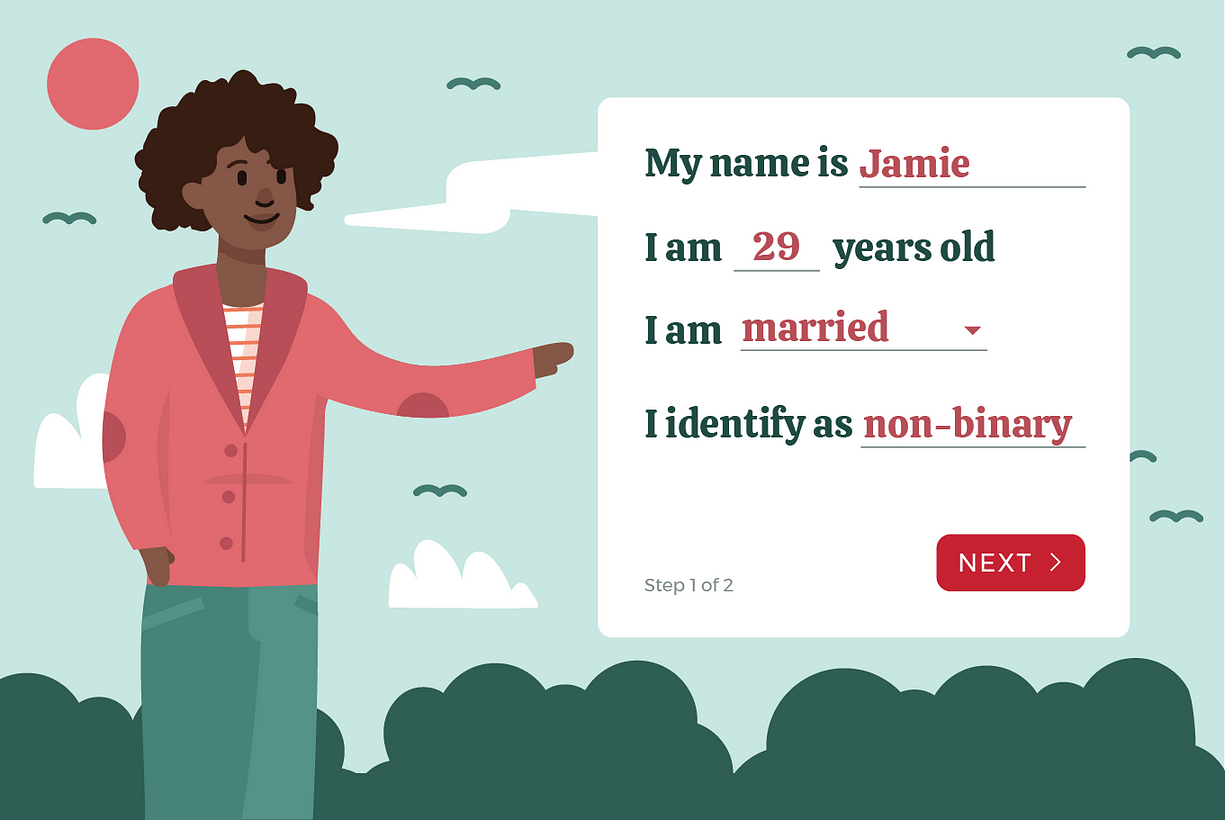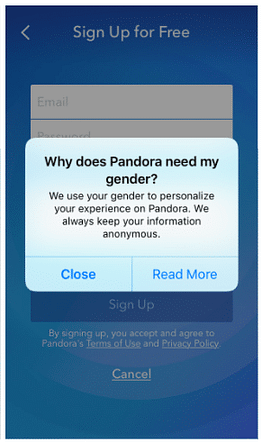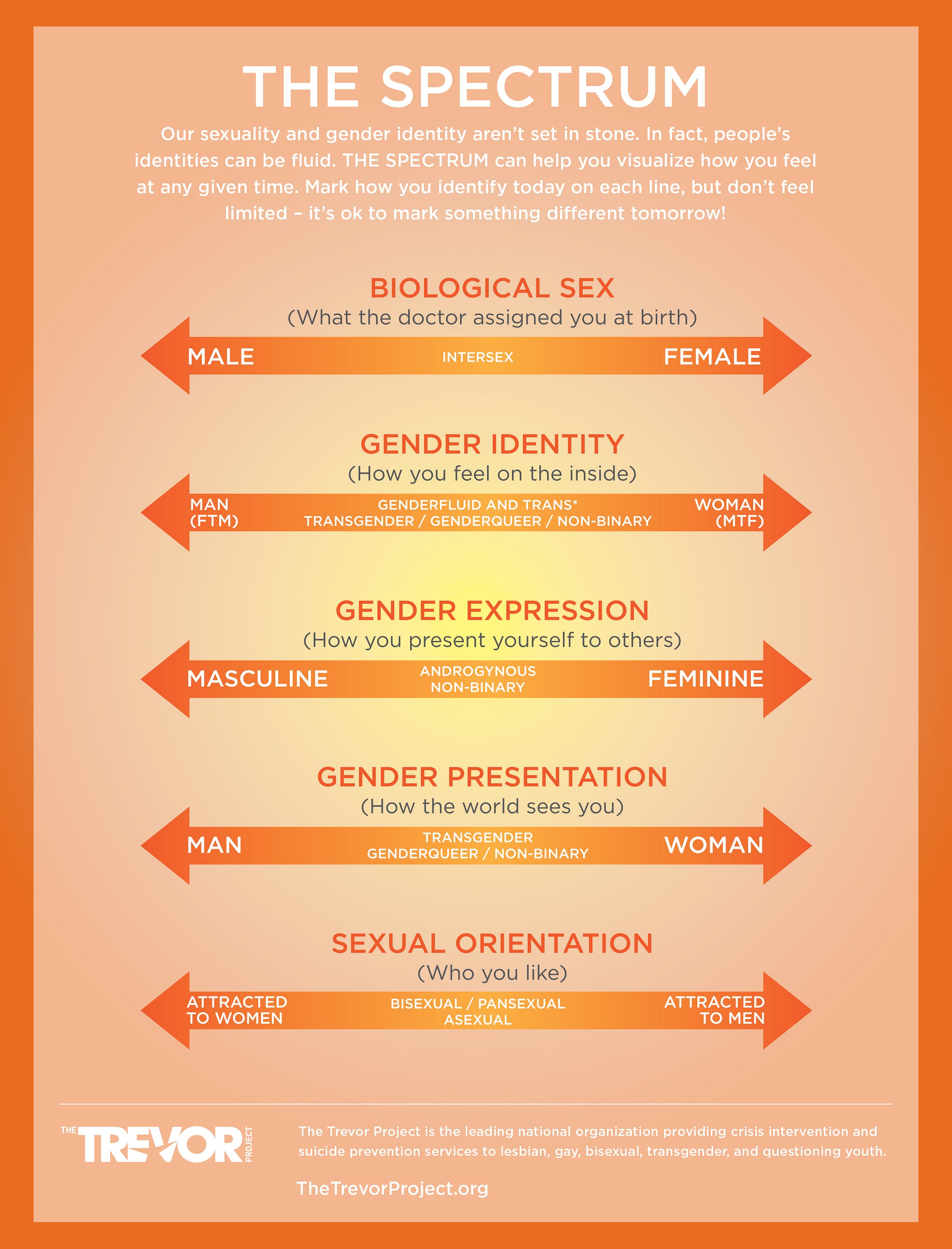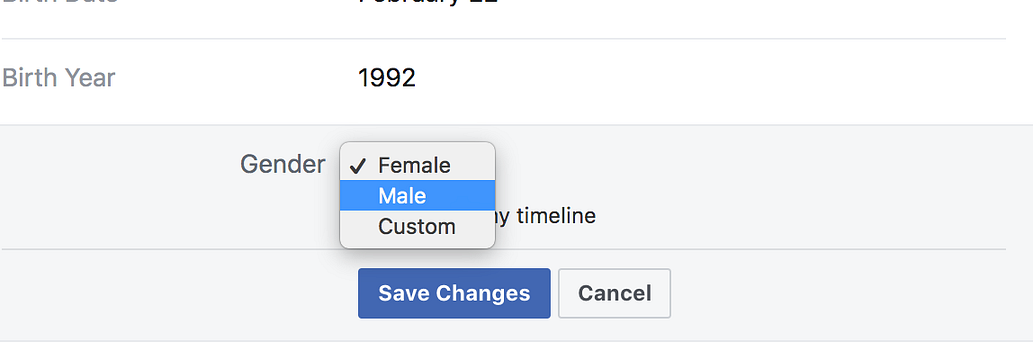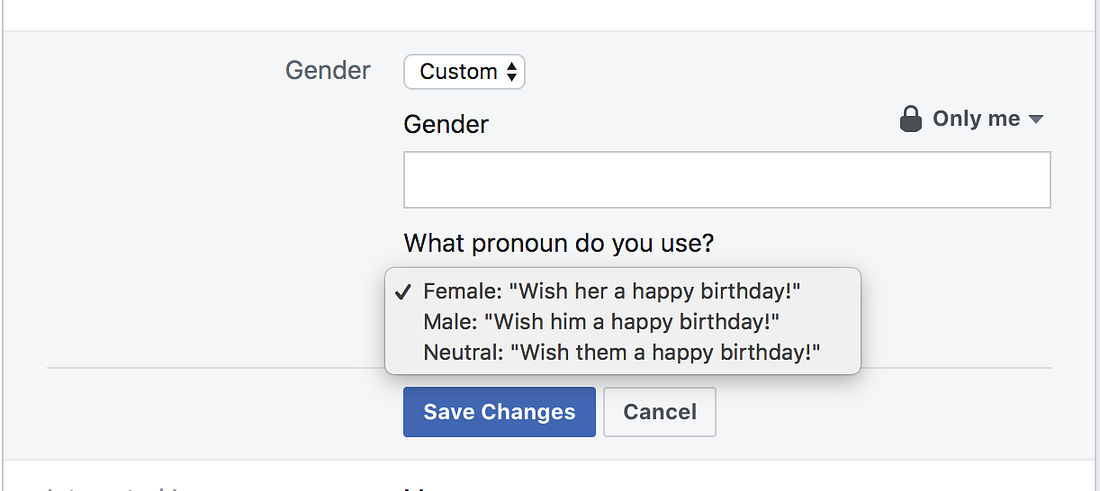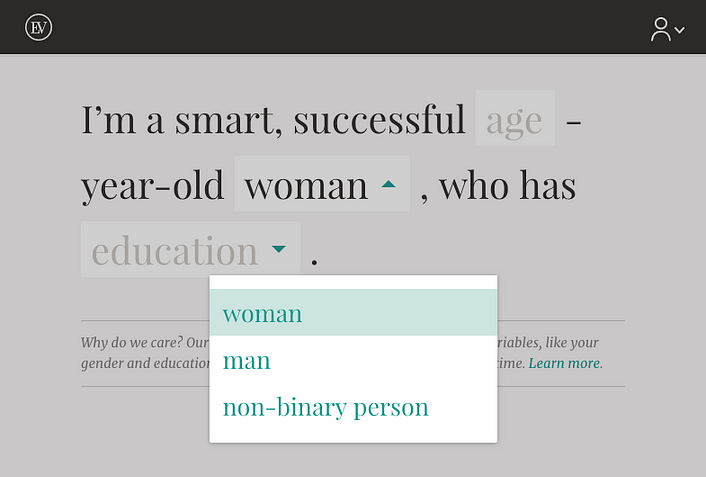Max Masure wrote a great article on why cisgender people should be normalizing pronoun usage that I would recommend for other cisgender people to help educate themselves. In this article, they mention how cisgender people can normalize gender diversity by including pronouns in their email, LinkedIn, website, etc. I think designers can take it a step further by adding more gender inclusion to the products we work on. Gender inclusion in our products is a small action that can have considerable impact. As designers, we advocate for the people we are serving, and so many of us say we are empathetic. Shouldn’t a cisgender designer’s empathy also extend to gender identity?
How to design beyond binary
The most common places that users identify their gender is in an onboarding experience or their user profile. In many cases, this is the first impression that someone gets from your product. It’s essential that it’s minimal and, yes, inclusive. Users can, and will, leave an onboarding experience if they determine they don’t like it or aren’t comfortable with the questions asked. Similarly, people will delete their accounts with products if those products can’t meet their needs. Gender inclusivity is especially relevant for companies that specialize in social media, health, finance, insurance, etc. Anywhere where gender data is gathered by an organization, you have an opportunity to do better. So let’s talk about how to be gender inclusive in your design processes.
Don’t ask for gender unless you need to
In any onboarding experience or any experience in which you request information from people, you should be asking yourself, “Is this question necessary?” We’ve all experienced the horrors of filling out lengthy forms. Forms are often considered an annoying experience, so much so that autofill is a thing. The same logic applies to asking for gender information. Honestly, while researching apps I have on my phone, I found a lot of them keep my gender information. In many instances, it makes sense. Each experience is different, and I know that gender plays a big part in marketing campaigns, but if you don’t really need gender information, try not to ask.
If your gender field is necessary, let people understand why
One emerging trend in onboarding experiences is explanatory text associated with form fields. Offering information to users in this way cultivates a trusting relationship from the moment a user begins interacting with your product. Spoiler alert: gaining a user’s trust is invaluable. It can make all of the difference in transforming casual users to evangelical.
Provide more gender options and let people change their gender at any time
Gender and sexuality in humans is fluid. You can Google “how many genders are there” and get a myriad of answers. There is so much more to gender and sexuality than a simple form can contain, so this is why I recommend allowing for multiple gender options, or even a custom gender selection. Facebook is one product that currently allows users to do both. They also allow people to change their gender at any time in their profile settings. These features are Facebook’s way of embracing a world that is not binary, allowing people to change and transition as they discover their gender identity. These are especially valuable when presented in the context of social media so that people can be socially seen in the same way they identify.
Let people pick their pronouns
In the same breath, allowing people to select their pronouns is also essential. It helps to clarify how someone identifies with their family and friends, or in something as simple as an email. This customization can make all of the difference to people who deal with gender dysphoria. Facebook also allows people to select their pronouns and will change the content that users interact with based on that selection. This small change can mean a significantly more positive experience for many of your users.
Cultivate content that isn’t binary
How many stock images are we going to have to look at with white/rich/straight/thin/cis people in this lifetime? How many articles do we have to read that speaks to all people in the same way? Representation matters, so let’s try to represent everyone. As someone who has had to find stock images for the past ten years of my life, I know that options can be limited and that better options tend to cost more. I know that data related to transgender individuals aren’t as common as we would like. Try your best, and advocate for better representation in the products you are working on. Culture shifts take time.
The business advantage
Inclusive design always has a moral value. But if you’re someone who cares about inclusivity and wants to build inclusive work, you’re going to have to get good at answering “what’s the business value?” You might be thinking, “why can’t we do what is right simply because it is right?” As someone who has been dealing with this question since the day I stepped into my career, I want to tell you honestly that I have felt that way too. But making a business case for the work you do is key to becoming a leader, to making change happen. The good news is that making a business case for something you are passionate about is an excellent way to learn how to win over stakeholders. For me, going to bat for the issues that mean the most to me is an easy thing because I will give it my all, and in most cases, I can win them over. Systemic change is about every little thing we can do better, it can be hard, but it’s worth it. On the other hand, if you’re someone who is reading this article asking why you should bother with building work that isn’t gender binary, you’ve come this far, and I respect that! I’ll do my best to answer this question.
Don’t leave money on the table
Can your business afford not to serve:
1.3 million adults are projected to be transgender 62 percent of Americans say they have become more supportive toward transgender rights 80 percent of “Gen Z,” believe that gender did not define a person as much as it used to
You might also say that transgender stigma can make users run away from your product. In some cases, this could be true, and it could be more problematic if your business is serving conservative clients. But we should never forget that our world is ever-changing. Millennials and Gen Z are coming into ages in which they have buying and voting power. If your product, especially an aging product, does not build support among younger generations, it is at a much higher risk of eroding. Additionally, products like Facebook have included gender diversity in their designs, and I do not see conservatives out there trying to ban it. Maybe they simply haven’t noticed it? Regardless, I suspect that gender-inclusive design will do more good than harm, especially in the long run.
Competitive advantage
If you’re in a newer organization or serving younger audiences, inclusive design can be one of the most advantageous moves you can make. Let’s take the example of Ellevest’s onboarding experience. In this, users can select from the options of male, female, and non-binary. For a business that is disrupting the financial industry, Ellevest is using gender inclusion to their advantage. Financial industries notoriously suffer from outdated and hyper rigid values. Ellevest has sought to go against those old financial industry practices and mirrors their values in the design. Doing this helps Ellevest stand apart even further from the industry it seeks to disrupt. This design also captures a new, younger, and specialized set of audiences, which is invaluable to startups.
Better audience segmentation
Audience segmentation is essential and the better we can do it, the more likely we are to gain sales and leads. Imagine what it would be like if we were able to serve a completely “new” subset of users from male and female and specialize in their needs. I can guarantee that people who are transgender aren’t going to have the same health needs or financial needs as a cisgender individual. As the number of people who identify as transgender increases, I anticipate we will need to segment their audience needs better.
Getting ahead of the big data curve
One of the issues we currently are facing in all products is a lack of data representing people who are transgender. As I mentioned, I anticipate that this will change quite quickly in the coming years and is already changing now. Getting ahead of this trend could be a massive win for any organization. There are businesses out there already doing this, but the time to invest in this segment of big data is now.
Attract Diverse Candidates
Businesses should know diverse teams with inclusive cultures are more profitable. Attracting diverse candidates requires many considerations, but one way to attract these candidates to your team is by being mindful of inclusivity in your products. In a report conducted in 2017 by McKinsey & Company, 1,000 companies were analyzed on their diversity and correlation between diversity and profitability. This study also measured longer-term value creation from diversity initiatives. Here are a few things they found:
Companies with a diverse workforce are 35 percent more likely to outperform those without diversity initiatives. Companies in the top 1/4 for gender diversity are 21 percent more likely to have a better financial return.
Message to transgender readers
As I mentioned earlier, I am a cis female. Your experience is not my experience, and in writing this, I only seek to be an ally and advocate. However, please leave a comment if I have missed the mark or if you feel I have not represented the needs of someone who is transgender. I’ll read over your responses and work on editing this piece to be better, and you will have my thanks! You are also welcome to message me privately if you are not comfortable commenting, feel free to email me. This article was originally published on uxdesign.cc
